|
A number of educational programs across North America have chosen to train and use teens as Hebrew Through Movement teachers. For some, it solves the challenge of finding adults are able to teach HTM, for others, it's a way to grow leadership for the present and future. This video is a recording of an August 2021 webinar that features two directors that address:
For a set of notes, click here.
0 Comments
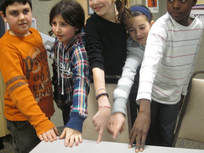 Energy and excitement are about to fill Hebrew classrooms across the nation! What a great time to re-examine programmatic goals for Hebrew Through Movement learning. Most teachers do a great job with the Foundational and Holiday Units, but I'm coming to believe that not as many educational programs are leveraging the power of the Prayer Units. And thus, this email ... Once learners have completed Foundational Level 6, teachers may use HTM to complement their work with prayers and blessings. The JECC makes it easy, with teaching ideas and resources available for free download from the HTM website. You'll find lots of assistance for working with Sh'ma and Its Blessings, as well as the Amidah. Shorter blessings are taught in a number of the Holiday Units. I know that many directors have seen the HTM exemplar video - the one that demonstrates teaching of the Four Questions. But, only some of you know that when we completed taping this lesson and turned off our camera, the students had strange looks on their faces. When asked why, they said that they never knew what the words meant. Yet, via this 15 minute lesson, the kinesthetic use of Hebrew Through Movement put the meaning of the target words into their kishkes. That, in itself is a great story, but the best part came a year later when a Cleveland Hebrew teacher spent three sessions teaching the Four Questions with all the techniques one could imagine - explanations, flashcards, technology, games, etc. But at the fourth session, she decided to teach the HTM lesson she had seen in our video. The teacher reported that when she completed the lesson, her students had strange looks on their faces. When she asked why, the children said they had no idea what the words meant before the Hebrew Through Movement lesson, even though they had three other learning sessions. Thus, this is the power of HTM for teaching prayers, blessings and rituals. Students learn vocabulary in a very natural and engaging way, with the language sticking deep in their kishkes. So, I challenge you to support your teachers in taking advantage of the power of the HTM Prayer Units. Give them a try, making sure to access all the other HTM resources available to you:
Nachama Skolnik Moskowitz Jewish Education Center of Cleveland  Hebrew Through Movement has been energizing Hebrew learning across North American for the last 5 years. With its start in Cleveland, OH over a dozen years ago, HTM brings laughter and smiles to the learning of Hebrew. And, because of its kinesthetic nature, Hebrew is sticking deep in the kishkes of its learners. While also part of learning in early childhood and day school settings, HTM has gained huge traction in part-time Jewish educational programs. Based on the number of educational programs who enrolled teachers in the Jewish Education Center of Cleveland’s online seminar (over 900), it would be easy to suggest that 9,000 – 15,000 youngsters have been jumping, running and pointing their way to Hebrew learning. [An overview video is here.] Why play the number game? Because it’s informing to consider how many children attending our Jewish summer camps might have a Hebrew background that is different from past generations of campers. It’s an opportune time to consider introduce Hebrew Through Movement at Jewish summer camps, creating a stronger synergy between Hebrew learning in congregational and camp settings! OVERVIEW OF THE LEARNING MODEL Hebrew Through Movement is based on the principles of “Total Physical Response” (TPR), developed by Dr. James J. Asher decades ago. TPR is an acquisitional language learning model, meaning that it follows the learning process of babies in their native language – they first hear language and then move their bodies in response (think of a baby who lifts her hands in the air when an adult says “up” right before lifting the child up). With multiple exposure, the young child develops a more sophisticated understanding of vocabulary – “chair” refers to that big soft brown item in the living room, the harder chairs in the dining room, and the highchair in which s/he is fed. Following the natural flow of a young child’s language learning, there are no expectations for learners to produce language in a Hebrew Through Movement lesson. Rather, the teacher offers commands and the campers react to the language. When learners hear לָקוּם lakum they stand up, and when they hear לָשֶׁבֶת lashevet they sit down. To lower the stress that often accompanies language learning, HTM learners are encouraged to watch and then mimic others, if needed. This creates a very social experience, bringing all into the fun and learning process. CAMP CONSIDERATIONS There is no doubt that HTM in Jewish summer camp looks different from a congregational or day school setting. Whereas the ultimate goal of Hebrew Through Movement in most congregations is to open up the Hebrew of rituals, prayers and blessings, summer camp allows for an expanded set of vocabulary like Hebrew names of camp buildings and locations, clothing, utensils used when eating, food, and names of sports. Hebrew Through Movement takes minimal time - lessons are only 10-15 minutes each, taught with a specific lesson structure that creates success. In part-time Jewish educational settings, HTM is scheduled each time that children are in session, once or twice a week. Camp offers the advantage of daily (or almost daily) Hebrew learning. A two week session, with 10 HTM lessons, would produce as much if not more learning than a part-time program once a week over a semester. Frequent, short learning opportunities, with little or no absences, creates a powerful language learning model. While Jewish summer camps are ideal Hebrew Through Movement laboratories, they also offer unique implementation challenges. However, these are easily mitigated.
THE CURRICULUM Learning begins with Foundational Units that teach that basic vocabulary that get learners moving, literally. In lessons taught completely in Hebrew campers are introduced to commands: Get up, sit down, stop, run, jump, spin, point to, lift up, etc. So as to fit the short bursts of learning time (10-15 minutes) the Hebrew infinitive is used לָקוּם (lakum; stand up) rather than the command forms directed to one male קוּם (kum), one female קוּמִי (kumi), or a group קוּמוּ (kumu). There simply isn’t enough time to help novice language learners gain all the grammatical nuances. These infinities are then combined with nouns, for example: Stand up and jump to the flower. לָקוּם וּלִקְפּוֹץ אֶל הַפֶּרַח Run to the dining hall. לָרוּץ אֶל חֲדַר הָאוֹכֶל Point to the cereal. לְהַצְבִּיעַ אֶל כוֹס מַיִם Lessons begin with a review of past vocabulary. Then, the teacher models the meaning of 3 new words, bringing campers into the movements and thus, the learning. Each lesson ends with an integration of the new learning with previous knowledge. Campers progress through at least five of the Foundational Units before branching off into thematic vocabulary. The Hebrew Through Movement curriculum guide includes Holiday Units, though other than Shabbat which teaches key vocabulary for ritual objects and blessings, these aren’t appropriate for camp. However, the original written curriculum guide also contains Prayer and Blessing Units which could be used at camp to open up the meaning of t’fillot prayed on a regular basis. BUT camp offers an environment that almost begs for other vocabulary to be introduced after campers have learned the basic, foundational commands. Camp staff members could choose to introduce in Hebrew
The Jewish Education Center of Cleveland has posted a camp-focused version of Hebrew Through Movement on the homepage of this website; it will be available for free download. Please let us know how HTM works at your camp! Come join the conversation on our Facebook group: https://www.facebook.com/groups/194398270732234/ (or search for Hebrew Moves Me!). 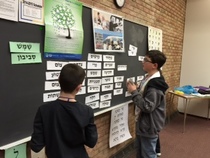 A director recently told me that her Hebrew Through Movement teachers are beginning to think about "what's next" for HTM - how will student learning continue next year for their classes? Each educational program will answer this question for itself, but here's a pattern that I've been seeing and encouraging:
The goal of Hebrew Through Movement is to open up for our students the blessings and prayers that are core to our rituals. A Cleveland-based Community of Practice has spent this year exploring what this could look like - you'll see the fruit of some of their labor on the Pesah Holiday Unit page including a really wonderful video that shows that it could mean to teach the Four Questions using HTM. But you'll also find on that page easy-to-download teaching scripts, pictures that illustrate vocabulary and concepts, and teaching notes, all from this quite productive group (way to go, Cleveland!). In addition, a Sh'ma and its Blessings curriculum that will be released by the JECC this summer, will include an integration of Hebrew Through Movement in the more common blessings/prayers taught in that section of our t'fillah. So, how are YOU thinking about the curriculum spiral for next year and what questions do you have? Feel free to post in the comment section (below), come join us in the "Hebrew Moves Me!" Facebook Group, ... or both!
I firmly believe that the Hebrew model that has been in use for decades is not serving our students well and that the learning process needs to honor sound-to-print language learning, even in our part-time settings. I’m not asking you to agree with me, but I would like to open the conversation. As mamy of you know, the JECC has been working on curricular materials that support a sound-to-print model of learning Hebrew, including Hebrew Through Movement and Let’s Learn Hebrew Side-by-Side. It would be wonderful if over the next few years, alternative curriculum and materials would be developed by other educators - ours is but one approach, and there will hopefullly be many! In the meantime, feel free to use this video as you wish. And please feel free to click the COMMENT button and share your thoughts, questions and concerns. Nachama Skolnik Moskowitz, JECC 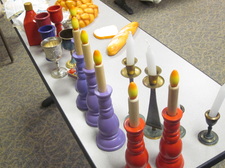 “No, it’s impossible.” That was my position, and that of many other educators, when asked about the efficacy of teaching Hebrew language in part-time Jewish educational settings of two sessions or less a week. But our tune has changed, thanks to the groundbreaking work of Dr. Lifsa Schachter and the pioneers who joined her in introducing Hebrew Through Movement (HTM) to children who attend “Hebrew School.” While some educational programs have been using this Hebrew language model for 4-6 years, most across the country are still in the early stages of implementing the curriculum for their students. At this point in time, the model adopted by most part-time Jewish educational programs includes:
It’s the latter point that is key to the use of Hebrew Through Movement in part-time Jewish educational settings, for a program that never moves its students beyond the Foundational Units loses the power of HTM for incredible and exciting Hebrew Jewish learning. Students who “play” with key words in prayers, blessings, rituals and songs, and then sing, recite or read the related Hebrew, have incredible ah-ha! moments as they realize they now understand a previously unintelligible language. Many of those using Hebrew Through Movement have hired specialists to rotate into classrooms on a regular basis. This allows for consistent scheduling, coherent teaching across the school, and the ability for the specialists to hone their craft. When a rotating specialist is used, most directors encourage classroom teachers to participate with the students in Hebrew Through Movement. The classroom teachers who learn basic Hebrew vocabulary and commands along with their students, are thus able to expand Hebrew learning beyond the 15 minutes formally scheduled, i.e., as students take out materials, line up by the door, or benefit from a quick burst of activity in between lesson segments. Alternatively, other educational programs hire enough teachers with sufficient Hebrew language background to teach Hebrew Through Movement in their own classrooms. While the Hebrew Through Movement website offers a fair amount of information about the teaching of HTM, the Jewish Education Center of Cleveland’s online seminar develops the specifically needed teaching skills to develop student success. And why introduce Hebrew Through Movement? For decades, Jewish educators have struggled to teach Hebrew in our part-time educational settings. Because we didn’t have enough time to teach Hebrew language AND prayer skills, we often focused on the latter, assuming all would be well. Teachers would generally start with print and move to sound – “this shape is a Mem and it has the sound of M – remember what it looks like and what it sounds like, but don’t confuse it with a Tet.” We’d teach that m’odekha means “with all your might” – an out-of-context word isolated from a grammatically complex prayer (V’ahavta). With this approach, many of our students felt duped after 4-5 years of Hebrew – the learning was hard, and often little was retained. Why do our children they struggle so much, retain so little, and (not surprisingly) bolt from our programs as quickly as possible after Bar or Bat Mitzvah? One reason is because we have been teaching Hebrew “backwards.” Our native language is learned in a progression from sound-to-print – babies hear words and sentences, begin to react to the conversations directed toward them, eventually begin to speak, and years later learn to read print. The sounds of language “in our ears” help beginning (and even advanced) readers learn to sound out and self-correct. As Jewish educators, we assumed that if our students had already learned to read in one language, we could jump over foundational language learning and just teach print (“this is the Mem”). Thus, “print-to-sound.” But by introducing Hebrew Through Movement, and spending a number of years providing an enriched approach to language, teachers have a chance of shifting children’s connection to Hebrew AND their ability to actually “read” (i.e., with meaning, albeit with a controlled vocabulary) as compared to “decode” (no understanding). A strong focus on prayer recitation, bringing the sounds of Hebrew prayers into our children’s heads and hearts each time they join together for learning, complements Hebrew Through Movement in creating a sound-to-print progression. And what else would help us move beyond “the impossible?” We can shift our learning of Hebrew decoding, delaying to fifth grade or beyond to allow for more time with Hebrew Through Movement and prayer recitation. The new approach to teaching the Alef-Bet and decoding/reading, Let’s Learn Hebrew Side-by-Side, builds on the Hebrew that children know just by living as Jews (Rosh Hashanah, mazel tov, Bar Mitzvah, etc) and from their Hebrew Through Movement lessons. Change is not easy, but our children are ready for an approach to Hebrew learning that builds on principles of language learning in use for years by French, Spanish, Russian and Chinese language specialists… never mind the learning “structures” that moms and dads of young babies have tapped into for millennia. It’s time, and no, teaching Hebrew language in our part-time settings is not impossible anymore! Nachama Skolnik Moskowitz, Jewish Education Center of Cleveland Online seminar registration information, as well as the free HTM curriculum, are on the homepage: http://www.HebrewThroughMovement.org 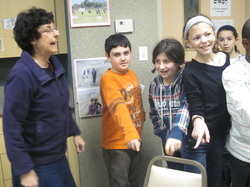 This past June the Jewish Education Center of Cleveland launched the online learning seminar that supports Hebrew Through Movement (for info see the bottom of the homepage, http://www.hebrewthroughmovement.org). Over 60 schools are represented among almost 140 teachers who've chosen to gain the skills to teach HTM to their students. Our goal is to upturn the current-way-of-doing-business in the teaching of Hebrew to students in part-time Jewish educational settings. We want to help students gain the language skills that will help increase their understanding of Jewish rituals and prayers (see the two videos on this page: http://www.hebrewthroughmovement.org/holiday-unit.html), and make the learning of Hebrew decoding/reading move along much more quickly and enjoyably! This is about leveraging the normative way of learning to read - from "sound-to-print" (think of how much language a baby hears and speaks before learning to read at age 5 or 6), rather than "print-to-sound" which is how Hebrew Schools have been doing it for decades (and struggling!) How's it going across the nation? Check out the Teacher Talk pages of this website - lots of conversation is going on there! Want to gain the skills to teach Hebrew Through Movement? Sign up for the online seminar - registration information is at the bottom of http://www.HebrewThroughMovement.org. Hebrew Through Movement is one element of a bigger transformation of Hebrew learning in our part-time educational programs. Read about the four things you can do to improve Hebrew learning for your students: http://tiny.cc/ntvorw Nachama Skolnik Moskowitz, JECC 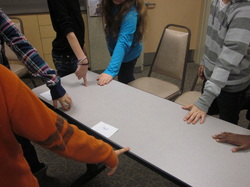 Dr. Schachter is the author of the curriculum, Hebrew Through Movement. Below are some of her thoughts directed especially to those supporting teachers in the classroom: I start from the premise, based on research and experience that it takes about five years for a new innovation to become fully entrenched in a school system. What often makes the difference is the support that supervisors provide to teachers new to a methodology. So here is a list of things that you can do:
I look forward to the ongoing conversation. Comments on this particular blog may be added below! Lifsa Dr. Lifsa Schachter, Professor Emerita 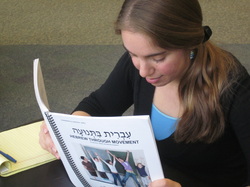 Besides our pilot group, there are have been three formal "start dates" with 20 teachers each into the JECC's online learning Hebrew Through Movement seminar. Another group is due to start at the end of the month. Together with the pilot, almost 100 teachers across the country are currently learning - or practicing - Hebrew Through Movement (TPR) in their classrooms this year. Kol hakavod to all who are part of this effort! Marcia, the facilitator working to support those in the seminar, and I have had some conversations along the way about how teachers are "taking on" Hebrew Through Movement on behalf of their students. There are some who are looking at the model quite purely - it's a format to be understood, practiced, and then student learning assessed so that next-steps can be determined. These teachers are adopting Hebrew Through Movement - the model researched by James J Asher and then adapted by Lifsa Schachter to part time Jewish educational settings. But there are other teachers who seem to be taking a different approach to Hebrew Through Movement - more than just adapting it to the nuances of their own settings, they seem to be taking pieces and parts, seeing this as another way to play Simon Says, though perhaps with a bit more sophistication. From our work in Cleveland, through the expert eyes and support of Dr. Lifsa Schachter, I have seen the benefits of adopting the model, rather than taking a Hebrew teaching concept from here and a method from there. Students come to know what to expect (though also know that the surprises that TPR brings will keep them engaged!). Good TPR learning is intentional, with vocabulary and sentence structure building upon each other so that students come to better understand Hebrew rituals and worship ... Hebrew understanding builds in the kishkes, rather than rote memorization of "5 words in V'ahavta." We encourage those learning to teach Hebrew via movement in their classrooms this year: ** Not to rush. Really. Take on 3 new words at a time and extend their use with your students. Watch the videos offered in the FOUNDATIONAL UNIT section of this website - they'll show you how the first few lessons might unfold ... and in a real classroom, there will be lessons in between these three. ** Not to overwhelm. Fifteen minutes is an optimal time for student learning EACH session. ** To understand that there are nuances to the teaching of Hebrew Through Movement that will take you time to deeply "get." Watch the video of the supervisor and the novice teacher on the BACKGROUND page of this website, as well as the mini-conversation between them at the end of the Level One teaching session (this is in the Foundational Unit section, on the tab that says 1-3). Trust us, this model takes time to learn well. ** To plan ahead for building fun into the lessons. How will you "surprise" students who think they know what you'll ask them to do next? If you've asked two students to run to the table at the front of the room, maybe the third student should be asked to jump backwards, or sit under the table upon arrival. Check out the Spanish video at the top of the HOME page ... students end up in the classroom closet! Yes, a bit surprising! ** Build competence. If you rush through the curriculum guide, students will never really "get" the vocabulary in their kishkes. Repeat previous phrases, be novel in your commands, and take your time. Hmm, did I say that before? Yep, just as I also talked earlier about kishke-learning... something that builds deep in one's gut. It has taken years of TPR sessions for students to get to the level of the 6th graders in the video linked in the "Transformative Power" section of the January 26, 2012 BLOG posting, below. See how the 1st and 2nd graders "get it," and then see where the 6th graders have grown to. ** To have reflective conversations with others. There are many schools with multiple teachers in the online seminar - collaboration is the way-to-go in matters of professional learning, as is support by a supervisor, director or peer teacher. To encourage working together, when three teachers register to the online seminar from one school, the JECC is happy to offer a "no-charge'supervisor's slot" for the fourth person into the course. The JECC's online learning seminar helps teachers competently take on in this powerful method of learning language. Registration information is at the bottom of the homepage of THIS website - http://www.HebrewThroughMovement.org. As I type this there are a few more spaces left in the mid-September "start date," and plenty of openings for the end of September and into October. Please feel free to post comments on this BLOG and/or in the TEACHER TALK section of the website. You can sign in easily with your Google or Facebook account - no "website membership" required. And remember, our curriculum guide was updated this summer - it may be freely downloaded from the HOMEpage of this website. Enjoy the start of the school year!! Nachama Skolnik Moskowitz, JECC Hebrew Through Movement is gaining steam! Classes in New Jersey and California have experimented with Hebrew Through Movement this year, joining the teachers in Cleveland who have worked with Hebrew TPR for years. All grew in their understanding of this engaging way to help students learn Hebrew.
A dozen teachers from across the country are currently piloting an online learning seminar. Nine modules guide teachers through about 10 hours of online learning that is supported by a very experienced Hebrew TPR teacher; you see her in a number of the videos on this site. Once the seminar is revised, it will be open to teachers at any time of day or night (yes, there will be a tuition charge). What have our teachers (us, too!) learned along the way?
Next steps for us? Over the summer we're going to be working on: ** Revising the curriculum guide (the experimental edition is available on the first page of this website for free download) ** Moving the online learning seminar from pilot to "real" ** Offering guidance for complementing one's decoding/reading program with principles from TPR ** Offering guidance for complementing one's prayer curriculum with TPR Over the summer, perhaps a camp will take on TPR as a great way to teach Hebrew. We'd love to know your questions, thoughts and feedback. Feel free to add a comment here, or post something in the Teacher Talk section of this website. Nachama Skolnik Moskowitz, JECC |
AuthorsThis blog will be updated by those supporting Hebrew Through Movement in a variety of ways. It might even be you! Categories
All
Archives
August 2021
|
